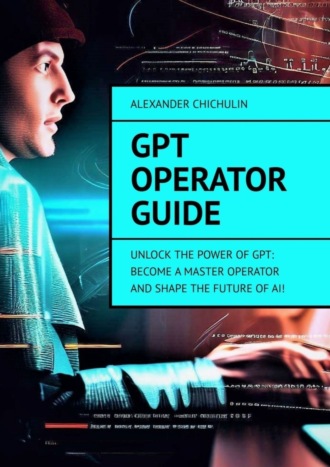
Полная версия
GPT Operator Guide. Unlock the Power of GPT: Become a Master Operator and Shape the Future of AI!

GPT Operator Guide
Unlock the Power of GPT: Become a Master Operator and Shape the Future of AI!
Alexander Chichulin
© Alexander Chichulin, 2023
ISBN 978-5-0060-1157-1
Created with Ridero smart publishing system
Introduction to GPT Operator
What is GPT?
GPT, which stands for “Generative Pre-trained Transformer,” is a state-of-the-art language model developed by OpenAI. It utilizes deep learning techniques, particularly transformer architectures, to generate human-like text responses based on given input prompts. GPT models have revolutionized natural language processing tasks and demonstrated impressive capabilities in various applications, including chatbots, language translation, content generation, and more.
GPT models are pre-trained on vast amounts of text data, which helps them learn grammar, context, and semantic relationships between words and sentences. This pre-training enables GPT models to generate coherent and contextually appropriate responses when provided with input text prompts. GPT models can be fine-tuned for specific tasks or deployed as general-purpose language models.
As a GPT Operator, your role involves managing and operating the infrastructure and systems required to deploy and maintain GPT models, ensuring their optimal performance and responsiveness.
Who is a GPT Operator?
1.2 Who is a GPT Operator?
A GPT Operator is a skilled professional responsible for the management, operation, and maintenance of GPT systems and infrastructure. They possess a deep understanding of GPT models, their deployment, and the underlying technologies involved. GPT Operators play a crucial role in ensuring the smooth functioning and performance of GPT models.
GPT Operators are typically involved in tasks such as setting up and configuring GPT systems, monitoring their performance, troubleshooting issues, and optimizing the models for various applications. They collaborate closely with data scientists, developers, and other stakeholders to fine-tune GPT models, integrate them into applications, and address any challenges that may arise during operation.
GPT Operators require a solid foundation in machine learning, natural language processing (NLP), and cloud computing. They should be adept at working with large datasets, have a good understanding of programming languages and frameworks, and possess strong analytical and problem-solving skills. Additionally, GPT Operators should be aware of ethical considerations related to AI, including bias mitigation and privacy concerns.
Overall, a GPT Operator plays a critical role in harnessing the power of GPT models and ensuring their efficient operation to deliver high-quality language generation and processing capabilities.
Role and Responsibilities of a GPT Operator
As a GPT Operator, you have a range of responsibilities related to the management and operation of GPT systems. Your role involves ensuring the optimal performance, reliability, and security of GPT models and infrastructure. Here are some key responsibilities:
1. GPT System Setup and Configuration: You are responsible for setting up the GPT system infrastructure, including servers, storage, and networking components. This involves installing and configuring software frameworks, libraries, and dependencies necessary for running GPT models.
2. Model Deployment and Management: You oversee the deployment of GPT models onto the infrastructure. This includes managing the versioning and updates of GPT models, ensuring compatibility with the system, and maintaining a library of available models.
3. Data Preparation for GPT Training: You work closely with data scientists and engineers to preprocess and prepare the data required for training GPT models. This may involve data cleaning, formatting, and ensuring data quality and relevance for optimal model performance.
4. Monitoring and Performance Optimization: You monitor the performance of GPT systems, keeping track of resource utilization, response times, and overall system health. You identify performance bottlenecks and optimize system configurations to achieve optimal throughput and responsiveness.
5. Troubleshooting and Issue Resolution: When issues or errors arise in GPT systems, you are responsible for diagnosing and troubleshooting them. This may involve investigating system logs, analyzing error messages, and working closely with developers and engineers to resolve issues promptly.
6. System Maintenance and Updates: You ensure that GPT systems are up to date with the latest software versions, security patches, and bug fixes. Regular system maintenance tasks, such as data backups, system upgrades, and system monitoring, fall under your responsibility.
7. Collaboration with Data Scientists and Developers: You collaborate with data scientists and developers to fine-tune GPT models for specific tasks or domains. This includes providing insights on system performance, assisting with model optimization, and implementing improvements based on feedback.
8. Security and Privacy Considerations: You ensure that GPT systems adhere to security and privacy best practices. This involves implementing access controls, encryption mechanisms, and data anonymization techniques to protect sensitive information processed by GPT models.
9. Documentation and Reporting: You maintain documentation related to GPT system configuration, procedures, and troubleshooting guidelines. You may also prepare reports on system performance, issues encountered, and recommendations for improvement.
10. Keeping Abreast of Developments: As a GPT Operator, you stay updated with the latest advancements in GPT technology, research papers, and best practices. This enables you to continuously enhance your skills and apply emerging techniques to improve system performance.
By fulfilling these responsibilities, you contribute to the efficient operation and utilization of GPT models, enabling organizations to leverage their language processing capabilities effectively.
Opportunities in the Field of GPT Operation
The field of GPT operation presents numerous opportunities for professionals looking to work with cutting-edge language models and contribute to the advancement of artificial intelligence. Here are some of the key opportunities in this field:
1. GPT Model Deployment and Management: Organizations across various industries, including technology, healthcare, finance, and marketing, require skilled GPT Operators to deploy and manage GPT models. This involves setting up infrastructure, configuring models, and ensuring their efficient operation.
2. System Optimization and Performance Tuning: GPT Operators with expertise in optimizing system performance and fine-tuning models can find opportunities to work on improving the speed, scalability, and efficiency of GPT systems. This includes identifying bottlenecks, implementing optimizations, and achieving high-performance results.
3. Collaboration with Data Scientists and Developers: GPT Operators often collaborate closely with data scientists and developers to refine and customize GPT models for specific applications. This collaboration provides opportunities to work on challenging projects, contribute to model improvements, and apply machine learning techniques.
4. Ethical and Bias Mitigation: With the growing concern about ethical considerations and bias in AI systems, there is a demand for GPT Operators who can address these issues. Opportunities exist to contribute to fair and responsible AI practices by implementing bias mitigation techniques, monitoring for ethical concerns, and ensuring privacy compliance.
5. Research and Development: The field of GPT operation offers opportunities for research and development in areas such as model architecture, training methodologies, and integration with other AI technologies. This includes exploring new techniques, experimenting with novel approaches, and contributing to advancements in the field.
6. Consulting and Training: As organizations adopt GPT models, there is a need for expert consultants and trainers who can guide them in setting up and operating GPT systems effectively. GPT Operators can leverage their knowledge and experience to provide consulting services, conduct training programs, and offer technical support to clients.
7. Career Advancement and Leadership Roles: GPT Operators who demonstrate strong technical skills, domain knowledge, and leadership qualities may have opportunities for career advancement. This could involve leading GPT teams, managing projects, and shaping the strategic direction of AI initiatives within organizations.
8. Entrepreneurship and Innovation: GPT Operators with entrepreneurial aspirations can explore opportunities to start their own AI-focused ventures. This could involve developing specialized tools or services related to GPT operation, consulting services, or creating novel applications that leverage GPT technology.
As the field of GPT operation continues to evolve, new opportunities are likely to emerge. By staying updated with advancements in AI and GPT technology, honing their skills, and embracing continuous learning, professionals in this field can position themselves for rewarding and impactful careers.
Getting Started as a GPT Operator
Education and Skills Required
To pursue a career as a GPT Operator, a combination of education and specific skills is essential. While formal education requirements may vary depending on the organization and specific job roles, here are the common educational backgrounds and skills that are beneficial for aspiring GPT Operators:
1. Education:
– Bachelor’s degree: A bachelor’s degree in computer science, data science, artificial intelligence, or a related field provides a strong foundation for a career as a GPT Operator. Relevant coursework may include machine learning, natural language processing, algorithms, and programming.
– Master’s degree: A master’s degree in the aforementioned fields can enhance your knowledge and expertise in AI and provide a competitive edge in the job market. Advanced coursework in deep learning, neural networks, and data engineering can be advantageous.
– Certifications: Completing certifications in machine learning, NLP, and cloud computing can demonstrate your proficiency and commitment to the field. Certifications from recognized institutions or platforms like OpenAI, Coursera, or Udacity can add credibility to your profile.
2. Technical Skills:
– Machine Learning and NLP: Strong knowledge of machine learning concepts, algorithms, and techniques is crucial. Familiarity with NLP tasks such as text classification, sentiment analysis, and sequence modeling is highly beneficial. Understanding transformer architectures, such as the ones used in GPT models, is essential.
– Programming: Proficiency in programming languages like Python is essential for GPT Operators. You should be comfortable with libraries and frameworks commonly used in machine learning and NLP, such as TensorFlow, PyTorch, or Hugging Face’s Transformers.
– Cloud Computing: Experience with cloud platforms like AWS, Azure, or Google Cloud is valuable for deploying and managing GPT systems. Knowledge of virtual machines, containers, and serverless computing is beneficial.
– Data Handling: GPT Operators should be skilled in working with large datasets, data preprocessing, and data cleaning. Experience with data manipulation libraries like Pandas and data storage technologies like SQL or NoSQL databases is advantageous.
– Problem-Solving and Analytical Skills: GPT Operators should have strong problem-solving abilities, be adept at analyzing system performance metrics, and have a data-driven approach to optimize GPT models and infrastructure.
3. Soft Skills:
– Communication: Effective communication skills are essential for collaborating with cross-functional teams, explaining complex concepts to stakeholders, and documenting procedures.
– Attention to Detail: GPT Operators should have a keen eye for detail to identify system issues, troubleshoot errors, and ensure the accuracy and quality of deployed models.
– Adaptability: The field of GPT operation is dynamic, with evolving technologies and best practices. GPT Operators should be adaptable to new methodologies, tools, and emerging trends.
– Continuous Learning: Keeping up with the latest advancements in AI, attending conferences, participating in online forums, and continuously upgrading skills are important for staying competitive in this field.
While a strong educational background and technical skills are important, practical experience through internships, personal projects, or participation in Kaggle competitions can significantly enhance your profile as a GPT Operator. Additionally, a genuine passion for AI and language processing, curiosity, and a willingness to learn are qualities that can set you apart in this field.
Training and Certification Programs
To further enhance your skills and knowledge as a GPT Operator, various training and certification programs are available. These programs provide structured learning and demonstrate your expertise in GPT operation. Here are some notable training and certification programs:
1. OpenAI GPT Training and Certification: OpenAI, the organization behind GPT models, offers training resources and certifications to deepen your understanding of GPT technology. They provide online courses, tutorials, and documentation that cover topics such as GPT system setup, deployment, fine-tuning, and ethical considerations.
2. Coursera: Coursera offers a range of courses related to machine learning, natural language processing, and deep learning that can enhance your skills as a GPT Operator. Courses such as “Natural Language Processing” and “Sequence Models” offered by top universities and institutions are highly regarded in the field.
3. Udacity: Udacity offers nanodegree programs in AI-related fields, including deep learning and natural language processing. These programs provide hands-on projects and mentorship opportunities, enabling you to gain practical experience and develop the skills needed for GPT operation.
4. TensorFlow Certification: TensorFlow, a popular deep learning framework, offers certification programs that cover various aspects of machine learning, including NLP. Earning a TensorFlow Developer Certificate demonstrates your proficiency in TensorFlow and deep learning concepts applicable to GPT models.
5. Hugging Face’s Transformers Certification: Hugging Face’s Transformers library is widely used in the implementation and fine-tuning of GPT models. They offer a certification program that focuses on the library’s usage, model deployment, and customizations. This certification showcases your expertise in working with GPT models.
6. Industry-specific Training: Depending on the industry you wish to specialize in, there may be industry-specific training programs available. For example, healthcare organizations may offer specialized training on using GPT models in healthcare applications, addressing regulatory compliance and data privacy concerns specific to the healthcare sector.
It’s important to research and evaluate the credibility and relevance of training and certification programs before enrolling. Consider factors such as the reputation of the institution or platform, the expertise of the instructors, the practicality of the curriculum, and the recognition of the certification within the industry.
While certifications can demonstrate your knowledge and commitment, practical experience gained through personal projects, internships, or working with GPT systems in real-world scenarios is equally valuable. The combination of practical experience and certifications can significantly enhance your profile as a GPT Operator and increase your career prospects in the field.
Understanding GPT System Architecture
To be an effective GPT Operator, it’s crucial to have a solid understanding of the underlying architecture of GPT systems. While the exact architecture may vary depending on the implementation and specific models used, here is a general overview of the GPT system architecture:
1. Transformer Architecture: GPT models are built on the Transformer architecture, which is a type of deep learning model specifically designed for sequence-to-sequence tasks. Transformers consist of encoder and decoder components that enable efficient processing of sequential data.
2. Encoder Stack: The encoder stack forms the primary component of the GPT architecture. It consists of multiple layers of self-attention and feed-forward neural networks. The encoder takes input text and processes it hierarchically, capturing contextual information at different levels of granularity.
3. Self-Attention Mechanism: The self-attention mechanism allows the model to focus on different parts of the input text when generating responses. It calculates attention weights for each input token, capturing dependencies and relationships between words in the sequence.
4. Positional Encoding: GPT models incorporate positional encoding to account for the sequential order of words. Positional encoding provides the model with information about the relative position of words in the input text, allowing it to understand the sequential context.
5. Vocabulary and Tokenization: GPT models typically use a large vocabulary of tokens to represent words, subwords, or characters. Tokenization is the process of splitting input text into these tokens, enabling the model to process and generate text at a granular level.
6. Fine-Tuning: GPT models are often fine-tuned for specific tasks or domains. Fine-tuning involves training the model on a task-specific dataset to adapt it to the target application. Fine-tuning adjusts the weights and parameters of the pre-trained GPT model to optimize performance for the specific task at hand.
7. Model Deployment and Serving: Once trained and fine-tuned, GPT models are deployed and served as API endpoints or integrated into applications. This allows users to provide input prompts and receive generated text responses from the GPT model.
Understanding the GPT system architecture helps GPT Operators in several ways. It enables them to:
– Configure and set up the infrastructure necessary to run GPT models.
– Optimize model performance by adjusting hyperparameters and fine-tuning techniques.
– Monitor and analyze system behavior to identify performance bottlenecks or errors.
– Collaborate effectively with data scientists and developers to integrate GPT models into applications.
– Troubleshoot issues and errors that may arise during system operation.
By gaining a deep understanding of the GPT system architecture, GPT Operators can efficiently manage and operate GPT systems, ensuring the optimal performance and effectiveness of the deployed models.
Familiarizing with GPT Models and Versions
As a GPT Operator, it’s important to familiarize yourself with the different GPT models and versions available. Understanding the characteristics, capabilities, and limitations of these models will help you make informed decisions when selecting and deploying the most appropriate GPT model for specific tasks. Here are key points to consider:
1. GPT Model Versions: GPT models are typically released in different versions, with each version representing an improvement or enhancement over the previous one. Stay updated with the latest versions to leverage new features, performance improvements, and bug fixes.
2. Model Size and Complexity: GPT models can vary in terms of size and complexity. Larger models tend to have more parameters and capture more fine-grained details but require more computational resources for training and deployment. Smaller models may be more suitable for resource-constrained environments but may sacrifice some performance.
3. Pre-Trained vs. Fine-Tuned Models: GPT models are often pre-trained on large-scale datasets to learn general language representations. However, fine-tuning allows models to adapt to specific tasks or domains. Understand the distinction between pre-trained and fine-tuned models and their implications for your use case.
4. Model Capacities and Tasks: GPT models can handle a wide range of natural language processing tasks, such as language generation, summarization, question answering, and translation. Familiarize yourself with the capabilities of different GPT models and their strengths in specific tasks.
5. Open-Source Implementations and Libraries: GPT models have been implemented and made available through open-source libraries, such as Hugging Face’s Transformers. Explore these libraries to access pre-trained GPT models, fine-tuning scripts, and tools for model deployment and management.
6. Research Papers and Documentation: Stay updated with research papers and documentation related to GPT models. Research papers often introduce novel architectures, training methodologies, and advancements in the field. Documentation provides insights into model usage, configuration, and fine-tuning guidelines.
7. Model Evaluation and Benchmarking: Evaluate and compare the performance of different GPT models using established evaluation metrics and benchmarks. This allows you to assess the model’s suitability for specific tasks and compare their strengths and weaknesses.
8. Community Forums and Discussions: Engage with the GPT community through forums, discussion groups, and online communities. These platforms provide opportunities to learn from experienced practitioners, share knowledge, ask questions, and stay informed about the latest developments in GPT models.
By familiarizing yourself with GPT models and versions, you can make informed decisions regarding model selection, fine-tuning strategies, and optimization techniques. This knowledge also helps in effectively communicating with data scientists, developers, and stakeholders involved in GPT projects, enabling collaborative decision-making and successful implementation of GPT systems.
Operating GPT Systems
GPT System Setup and Configuration
Setting up and configuring a GPT system is a critical task for a GPT Operator. This involves preparing the infrastructure, installing the necessary software and dependencies, and configuring the system for optimal performance. Here are the steps involved in GPT system setup and configuration:
1. Infrastructure Planning: Determine the infrastructure requirements based on the scale of your deployment and expected workload. Consider factors such as the number of GPT models, the size of the models, expected concurrent users, and computational resources needed for training and inference.
2. Hardware Selection: Choose the appropriate hardware for your GPT system, considering factors such as processing power, memory capacity, and storage requirements. GPUs or TPUs are commonly used to accelerate the training and inference of GPT models due to their parallel processing capabilities.
3. Software Installation: Install the necessary software and frameworks for GPT system operation. This typically includes Python, machine learning libraries like TensorFlow or PyTorch, and any additional dependencies specific to the GPT models or frameworks you will be using.
4. Data Preparation: Prepare the data required for training or fine-tuning the GPT models. This involves collecting or curating the dataset, performing data preprocessing tasks such as cleaning and tokenization, and splitting the data into training, validation, and test sets.
5. Model Acquisition: Obtain the required GPT models for your system. Depending on your use case, you may choose to use pre-trained models available from open-source repositories like Hugging Face’s Transformers or fine-tune models on your specific task or domain.
6. Model Deployment: Set up the model deployment infrastructure, such as API endpoints or serving mechanisms, to make the GPT models accessible for inference. This involves configuring the server software, defining the API endpoints, and managing the model serving lifecycle.











